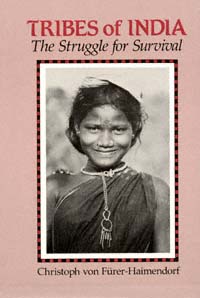
University of California >>
Free eBook (PDF) >>
Summary & Contents >>
A chance discovery of ‘Koyaboli’ or Gondi (dialect) script recently in Adilabad district has opened new vistas in the educational and cultural development of the major primitive Gond tribe in the country besides creating scope for deeper research in Proto-Dravidian languages. The find is so recent that it has yet to gain broader acceptance, but enthusiasts like former Director of AP Oriental Manuscripts Library and Research Centre (APOMLRC) Professor Jayadheer Tirumal Rao and his team have started working on it for realisation of its full potential.
“The new find could well be the all important link to Proto-Dravidian languages. It can help in retracing the origins of these languages”, the well-known manuscript expert from Andhra Pradesh opined as he talked of the much promising event recently on the sidelines of the Akhand Bharatiya Gondwana Gondi Sahitya Darbar at Gunjala village in Narnoor mandal where the dozen Gondi manuscripts were found.
Prof. Rao said the discovery of the script had even made the Gonds rediscover their old pride and self-respect.
The extra spring in the gait of the organisers of the Darbar and the plans for future indicated his contention to be right. “The plan is to run a Gondi language school permanently at Gunjala for Gond children to learn their mother tongue up to SSC. Students at Intermediate and Degree level will learn the language at a facility at Utnoor and those at Post-Graduate level will study it at Hyderabad”, he said after participating in the inauguration of the school as the key initial measure being undertaken by the Gond community in development of their language.
“Among other developments, a temple like structure for ‘reverence’ of the Gondi script, which has been named Gunjala Gondi Lipi, will be constructed at this village. Efforts will also be made for acceptance of the language in the literary world and at international level too”, he revealed.
Professor G. Manoja of Palamur University, Mahabubnagar and Edcational Puppeteer Padmini Rangarajan from Hyderabad attended the Darbar.
Source: “Chance discovery of Gondi script opens new vistas of tribal culture” by S. Harpal Singh, The Hindu, 30 January 2013
Address : https://www.thehindu.com/news/national/andhra-pradesh/chance-discovery-of-gondi-script-opens-new-vistas-of-tribal-culture/article4359780.ece
Date Visited: 7 November 2021
Research the above issues with the help of Shodhganga: A reservoir of theses from universities all over India, made available under Open Access >>
“There is a need to explore the tribal consciousness in the backdrop of climate change, development, and deforestation.” – Deepanwita Gita Niyogi in “India’s Adivasi Identity in Crisis” Pulitzer Center May 27, 2021 | Learn more about climate change and illegal mining | United Nations on climate change | Find free publications on India’s hunter-gatherers in the Unesco Digital Library >>
The district derives its name from Adilabad,its headquarters town which was named after the ruler of Bijapur, Ali Adil Shah. The district was for long not a homogenius unit and its component parts were ruled at different periods by nasties namely, the Mauryas, Staavahanas, Vakatakas, Chaludyas of Badami, Rashtrakututs, Chalukyas of Kalyani, Mughals, Bhosle Rajes of Nagpur and Asaf Jahis, besides the Gond Rajas of Sirpur and Chanda. Originally this was not full fledged district but a sub-district named Sirpur-Tandur which was created in A.D. 1872 with Edlabad (Adilabad), Rajura and Sirpur as its consistuents talukas. In 1905 the status of this sub-district was raised to that of an independent district with head quarters at Adilabad.
Source: Official Website Of Adilabad Collectorate
Address : http://adilabad.ap.nic.in/profile.html
Date Visited: Fri Jul 05 2013 15:44:06 GMT+0200 (CEST)
Among the tribal populations of India there is none which rivals in numerical strength and historical importance the group of tribes known as Gonds. In the late 1970s, numbering well over four million, Gonds extend over a large part of the Deccan and constitute a prominent element in the complex ethnic pattern of the zone where Dravidian and Indo-Aryan populations overlap and dovetail.
In the highlands of the former Hyderabad State (now Andhra Pradesh) concentrations of Gonds persisted in their traditional lifestyle until the middle of the twentieth century: feudal chiefs continued to function as tribal heads and hereditary bards preserved a wealth of myths and epic tales. It was at that time that Christoph von Fürer-Haimendorf first began his study of this group of Gonds, spending the better part of three years in their villages. While observing their daily life and their elaborate ritual performances, he also saw the threat which more advanced Hindu populations, infiltrating into the Gonds’ habitat and competing for their ancestral land, were posing to their way of life. […]
In 1979 the Gonds were once again being subjected to the pressure of outside forces and Professor von Fürer-Haimendorf lays special emphasis on the analysis of the process of social change forced upon the Gonds by settlers from outside. The last part of the book thus represents a case history of the transformation of a tribal society under the impact of modernisation and relentless population growth. | Table of Contents >>
Source: “The Gonds of Andhra Pradesh Tradition and Change in an Indian Tribe” By Christoph von Fürer-Haimendorf, Elizabeth von Fürer-Haimendorf” (Routledge, December 2021)
URL: https://www.routledge.com/The-Gonds-of-Andhra-Pradesh-Tradition-and-Change-in-an-Indian-Tribe/Furer-Haimendorf-Furer-Haimendorf/p/book/9781032156484
Date Visited: 7 November 2021
[Bold typeface added above for emphasis]
Learn more about the Gond community >>
Tip: for more resources, type other keywords of interest in the above Search window or on archive.org >>
Internet Archive is a non-profit library of millions of free books, movies, software, music, websites, and more.

Tribal Arts in India >>
See also